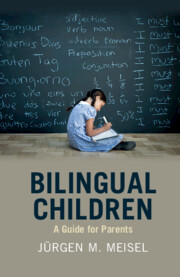Book contents
- Bilingual Children
- Bilingual Children
- Copyright page
- Dedication
- Contents
- Preface
- Abbreviations
- 1 Bilingualism in Early Childhood
- 2 How Infants Become Native Speakers
- 3 Two Languages in One Mind
- 4 Keeping Languages Apart
- 5 Language Dominance
- 6 Trilingual and More
- 7 The Age Question
- 8 Benefits and Advantages of Child Bilingualism
- Bibliography
- Index
- References
3 - Two Languages in One Mind
Differentiating Linguistic Systems
Published online by Cambridge University Press: 08 June 2019
- Bilingual Children
- Bilingual Children
- Copyright page
- Dedication
- Contents
- Preface
- Abbreviations
- 1 Bilingualism in Early Childhood
- 2 How Infants Become Native Speakers
- 3 Two Languages in One Mind
- 4 Keeping Languages Apart
- 5 Language Dominance
- 6 Trilingual and More
- 7 The Age Question
- 8 Benefits and Advantages of Child Bilingualism
- Bibliography
- Index
- References
Summary
The most frequently expressed concern is whether early bilinguals will be able to differentiate their languages. Research on child bilingualism has demonstrated that this is indeed the case. Children acquiring two languages simultaneously are able to differentiate their lexical and grammatical systems from very early on. Ocassional language mixing is not an indication of an underlying unitary system, fusing two or more linguistic competences. Rather, mixing is a performance phenomenon. Most mixed utterances are instances of code-switching, i.e. linguistic behaviour constrained by grammatical and sociolinguistic principles. Early mixes may also result from a choice of language that is unexpected from an adult perspective. Choosing the adequate language in bilingual settings requires sociolinguistic knowledge that is acquired in the course of children’s socialization. Parents can support bilingual L1 acquisition by their own linguistic behaviour. Following the ‘one person, one language’ (OPOL) principle is a method that has been applied successfully for over 100 years.
Keywords
- Type
- Chapter
- Information
- Bilingual ChildrenA Parents' Guide, pp. 58 - 92Publisher: Cambridge University PressPrint publication year: 2019



